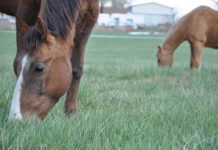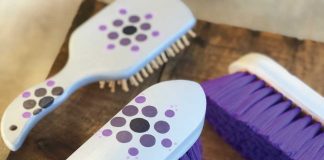The following plant-derivatives are frequently included in the ingredient lists of many natural products (and even some that are not). From fly sprays to shampoos, check them out to see what they can do for your horse.
Cedarwood was used by North American Indians to treat a variety of ailments including arthritis and skin rashes. It is effective for repelling insects and vermin, including mosquitoes, moths and rats, and is used extensively in insect repellents and as a fragrance in soaps.
Chamomile has long been used as a skin-care remedy due to its anti-inflammatory effects, and in soaps, cosmetics and detergents.
Citronella, from citronella grass, has anti-inflammatory and sedative effects. Its long history of use as an insect repellent makes it a component in many natural fly sprays. Undiluted, it sometimes creates minor skin irritations so it is generally diluted in a vegetable oil base.
Clove is not only a pungent spice, but is also effective as an antibiotic and antiseptic, antiviral, larvicide and insect repellent.
Eucalyptus, native to Tasmania and Australia, occurs as more than 700 different species of which at least 500 produce a type of essential oil. The many actions include analgesic, antiseptic (for cuts, sores and wounds), parasiticide, fungicide and insecticide. It is used commercially as a fragrance component in soaps and as an active ingredient in insect repellents.
Fennel was used traditionally to convey longevity, courage and strength, and to ward off evil spirits. Today it is valued as an antiseptic and antimicrobial, and its fragrance is pleasing in soaps and as a masking agent in insecticides.
Geranium has been used since antiquity and is still employed today as an anti-inflammatory, antiseptic, astringent, deodorant, and fungicide, as well as a fragrance component in soaps.
Lavender has long been used as a folk remedy and for its lovely fragrance. It still plays an important role as an analgesic, anitimicrobial, antiseptic and insect repellent.
Marigold is highly regarded for its antiseptic and anti-inflammatory properties and is effective for the treatment of skin problems including wounds, rashes, infections. It has long been grown as a border in vegetable gardens to help with insect control and is now a prime ingredient in at least one equine fly repellent.
Pennyroyal is a well-established herbal remedy with many uses today including that of antiseptic and insect repellent.
Rose was widely used through the Middle Ages to treat complaints ranging from headaches to liver congestion. Today, it is recognized for many actions including that of an antiseptic and as an antiviral and bactericidal agent.
Sage has a long history of use for its culinary and medicinal qualities. Its actions include that of antimicrobial, antiseptic, astringent and insecticide.
Tea Tree Oil comes from a common Australian tree and has a long history of use by the Aborigines. It has proven effective against bacteria, fungi and viruses. It is currently used in some shampoos, conditioners and shines and has been employed for centuries as an insect repellent.
Thyme, one of the earliest medicinal plants, was used by Hippocrates and Ancient Greeks as a fumigating agent against infectious diseases and by Ancient Egyptians in the embalming process. It is now known as an effective antimicrobial and fungicide and is used as a fragrance in soaps.
Witch Hazel leaves and bark were used by Native Americans to make poultices to treat cuts, scrapes and insect bites. Today we know that it has distinct anti-inflammatory and astringent properties and is also effective in relieving sore muscles.
Yarrow is an age-old herbal medicine. Current uses include that of anti-inflammatory, antiseptic, skin toner and hair rinse as it purportedly promotes hair growth.
Natural Selection
Producers of natural grooming products for horses come from a variety of backgrounds. Some are well established in the horse product world and have added a natural selection to their traditional line. Some make products for both humans and animals, while others are devoted exclusively to manufacturing a natural product line for animals. When selecting a natural grooming aid for your horse, read the labels and choose the product best suited for your horse and your purposes.
Click here for more information on holistic horse care.







A really good natural detangler/conditioner is EQyss avocado mist. It smells so good!
We use the Simple Relief line at our training facility. They use essential oils in their products and we’ve had amazing results with them. I highly recommend them not just because they’re natural but because they work.
All of the old treatments are good for the time but a product developed in 1998 for human sore muscles arthritis sun burn it not a cure but does relieve pain and can be used for long periods of time. It is REAL TIME PAIN RELIEF my website on google is http://www.txrtpr.com you can see what its contents are you may want to try this for some of your ailments and you animals ailments can’t hurt its all natural. I’m not a DMV just a vendor it works so good for human relief sore muscles, arthritis, sun blister and more.